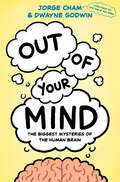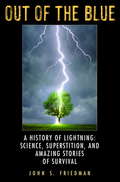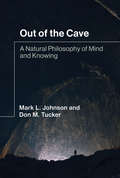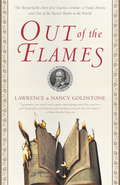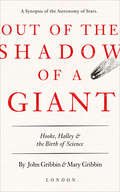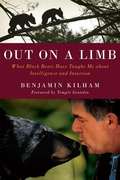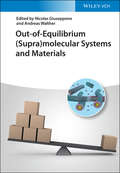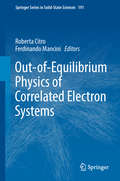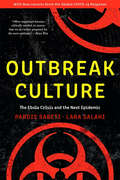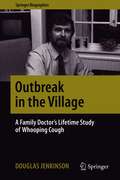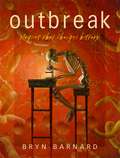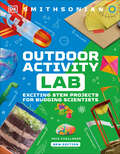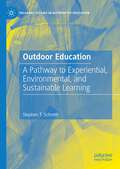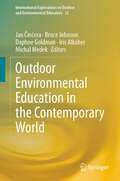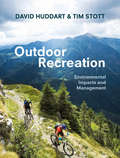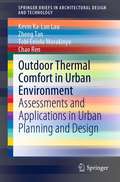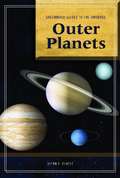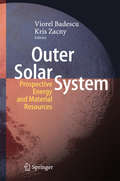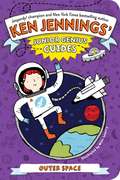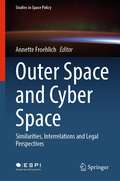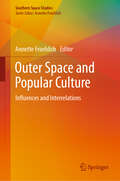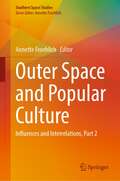- Table View
- List View
Out of Your Mind: The Biggest Mysteries of the Human Brain
by Jorge Cham Dwayne GodwinFrom the creator of WE HAVE NO IDEA, an introductory journey into your own mind—if your inner voice had a Ph.D. in brain science, cracked jokes, and drew cartoons.Why do you love? Why do you lie? What makes you happy? Every single thought you have comes from one place: your brain. But what makes it tick? How much of it have we decoded, and how much of it remains an impenetrable mystery? Join best-selling author and online cartoonist Jorge Cham and neuroscientist Dwayne Godwin on a deep dive into the fascinating world of the human brain, in which they will explore questions such as: What is consciousness? Where is you in the brain? And do we have free will? All while illuminating everything we know (and DON&’T know) about one of the most complex objects in the known universe. Think of it as conversation-ammunition for your next cocktail party, or a quick fascinating read while you&’re in the bathroom (don&’t worry, the chapters aren&’t that long). Centered around questions we all ask ourselves at some point but don&’t usually have answers to, Out of Your Mind is an illustrated book about the brain that isn&’t too brainy. Playful, accessible, and deeply insightful, it&’s the one brain book that&’s truly accessible and suitable for all brains.
Out of the Blue
by John S. FriedmanThe odds of being hit by lightning each year are only about 1 in 750,000 in the U. S. And yet this rare phenomenon has inspired both fear and fascination for thousands of years. In this groundbreaking, brilliantly researched book, journalist John S. Friedman probes lightning’s scientific, spiritual, and cultural roots. Blending vibrant history with riveting first-hand accounts of those who have clashed with lightning and lived to tell about it,Out of the Bluecharts an extraordinary journey across the ages that explores our awe and dread in the face of one of nature’s most fearsome spectacles. Herman Melville called it “God’s burning finger. ” The ancient Romans feared it as the wrath of God. Today we have a more scientific understanding, so why our eternal fascination with lightning?Out of the Blueattempts to understand this towering force of nature, exploring the changing perceptions of lightning from the earliest civilizations through Ben Franklin’s revolutionary experiments to the hair-raising adventures of storm chasers like David Hoadley, who’s been chronicling extreme weather for half a century. And Friedman describes one of the most treacherous rescues ever attempted in American mountain climbing. Friedman profiles a Virginia ranger who was struck by lightning seven times—and dubbed the human lightning rod—along with scores of others who tell astonishing tales of rescue and survival. And he charts lightning’s profound, life-altering effects on the emotional and spiritual lives of its victims. Combining captivating fact with thrilling personal stories,Out of the Bluetells a remarkable true tale of fate and coincidence, discovery and divine retribution, science and superstition. As entertaining as it is informative, it is a book for outdoor adventurers, sports enthusiasts, science and weather buffs, nature lovers, and anyone who has ever been awed or frightened by the sight of lightning. From the Hardcover edition.
Out of the Cave: A Natural Philosophy of Mind and Knowing
by Mark L. Johnson Don M. TuckerFrom a philosopher and a neuropsychologist, a radical rethinking of certain traditional views about human cognition and behavior.Plato's Allegory of the Cave trapped us in the illusion that mind is separate from body and from the natural and physical world. Knowledge had to be eternal and absolute. Recent scientific advances, however, show that our bodies shape mind, thought, and language in a deep and pervasive way. In Out of the Cave, Mark Johnson and Don Tucker--a philosopher and a neuropsychologist--propose a radical rethinking of certain traditional views about human cognition and behavior. They argue for a theory of knowing as embodied, embedded, enactive, and emotionally based. Knowing is an ongoing process--shaped by our deepest biological and cultural values. Johnson and Tucker describe a natural philosophy of mind that is emerging through the convergence of biology, psychology, computer science, and philosophy, and they explain recent research showing that all of our higher-level cognitive activities are rooted in our bodies through processes of perception, motive control of action, and feeling. This developing natural philosophy of mind offers a psychological, philosophical, and neuroscientific account that is at once scientifically valid and subjectively meaningful--allowing us to know both ourselves and the world.
Out of the Flames: The Strange Journey of Michael Servetus and One of the Rarest Books in the World
by Lawrence Goldstone Nancy GoldstoneMichael Servetus is one of those hidden figureheads of history who is remembered not for his name, but for the revolutionary deeds that stand in his place. Both a scientist and a freethinking theologian, Servetus is credited with the discovery of pulmonary circulation in the human body as well as the authorship of a polemical masterpiece that cost him his life. The Chrisitianismi Restituto, a heretical work of biblical scholarship, written in 1553, aimed to refute the orthodox Christianity that Servetus' old colleague, John Calvin, supported. After the book spread through the ranks of Protestant hierarchy, Servetus was tried and agonizingly burned at the stake, the last known copy of the Restitutio chained to his leg. Servetus's execution is significant because it marked a turning point in the quest for freedom of expression, due largely to the development of the printing press and the proliferation of books in Renaissance Europe. Three copies of the Restitutio managed to survive the burning, despite every effort on the part of his enemies to destroy them. As a result, the book became almost a surrogate for its author, going into hiding and relying on covert distribution until it could be read freely, centuries later. Out of the Flames tracks the history of this special work, examining Servetus's life and times and the politics of the first information during the sixteenth century. Lawrence and Nancy Goldstone follow the clandestine journey of the three copies through the subsequent centuries and explore its author's legacy and influence over the thinkers that shared his spirit and genius, such as Leibniz, Voltaire, Rousseau, Jefferson, Clarence Dorrow, and William Osler. Out of the Flames is an extraordinary story providing testament to the power of ideas, the enduring legacy of books, and the triumph of individual courage.
Out of the Shadow of a Giant: Hooke, Halley, & the Birth of Science
by John Gribbin Mary GribbinThe authors of Ice Age &“present a well-documented argument that [Newton] owed more to the ideas of others than he admitted&” (Kirkus Reviews). Robert Hooke and Edmond Halley, whose place in history has been overshadowed by the giant figure of Newton, were pioneering scientists within their own right, and instrumental in establishing the Royal Society. Although Newton is widely regarded as one of the greatest scientists of all time and the father of the English scientific revolution, John and Mary Gribbin uncover the fascinating story of Robert Hooke and Edmond Halley, whose scientific achievements neatly embrace the hundred years or so during which science as we know it became established. They argue persuasively that, even without Newton, science would have made a great leap forward in the second half of the seventeenth century, headed by two extraordinary figures, Hooke and Halley. &“Science readers will thank the Gribbins for restoring Hooke and Halley to the prominence that they deserve.&”—Publishers Weekly &“Engaging . . . They offer proof that Hooke was an important scientist in his own right, and often had physical insights that were borrowed (usually without acknowledgement) by Newton.&”—Choice
Out of this World
by Clive GiffordAre you baffled by the Big Bang? Curious about what it's like to walk on the moon? Wondering if someday you might meet an alien? Dreaming of becoming an astronaut? This fun, comprehensive book is bursting with all the cool things you ever wanted to know about space. In Out of Space you will discover . . .· The Earth, the Moon, and in Between--From the birth of our planet and its fascinating blueprint to its amazing atmosphere and our nearest neighbor, the moon!· Earth's Neighborhood--From the eight planets in our solar system and the characteristics that set them apart to the mystifying facts about comets and meteoroids.· Seething Stars and Giant Galaxies--From the life of the star and its various sizes and shapes to the 200 billion that make up the Milky Way.· Stargazing--From the accounts and theories of the ancient astronomers to today's scientists and their search for the extraterrestrial.· Exploring Space--From the first-known rockets to today's mighty spacecraft and the famous missions that advanced our exploration.· How It All Began . . . and Might End--From scientists' theories about the dawn of time to the fierce debate about how, when--and if--the universe may end someday.
Out on a Limb
by Benjamin KilhamIn Out on a Limb, Ben Kilham invites us into the world he has come to know best: the world of black bears. For decades, Kilham has studied wild black bears in a vast tract of Northern New Hampshire woodlands. At times, he has also taken in orphaned infants-feeding them, walking them through the forest for months to help them decipher their natural world, and eventually reintroducing them back into the wild. Once free, the orphaned bears still regard him as their mother. And one of these bears, now a 17-year-old female, has given him extraordinary access to her daily life, opening a rare window into how she and the wild bears she lives among carry out their daily lives, raise their young, and communicate. Witnessing this world has led to some remarkable discoveries. For years, scientists have considered black bears to be mostly solitary. Kilham's observations, though, reveal the extraordinary interactions wild bears have with each other. They form friendships and alliances; abide by a code of conduct that keeps their world orderly; and when their own food supplies are ample, they even help out other bears in need. Could these cooperative behaviors, he asks, mimic behavior that existed in the animal that became human? In watching bears, do we see our earliest forms of communications unfold? Kilham's dyslexia once barred him from getting an advanced academic degree, securing funding for his research, and publishing his observations in the scientific literature. After being shunned by the traditional scientific community, though, Kilham's unique findings now interest bear researchers worldwide. His techniques even aid scientists working with pandas in China and bears in Russia. Moreover, the observation skills that fueled Kilham's exceptional work turned out to be born of his dyslexia. His ability to think in pictures and decipher systems makes him a unique interpreter of the bear's world. Out on a Limb delivers Kilham's fascinating glimpse at the inner world of bears, and also makes a passionate case for science, and education in general, to open its doors to different ways of learning and researching-doors that could lead to far broader realms of discovery. Kilham and his work have been featured in five internationally televised documentaries. In addition to being on over forty nationally broadcast radio shows including National Public Radio, he has appeared on The Today Show, Good Morning America, ABC Nightly News, The David Letterman Show, and more.
Out-of-Equilibrium (Supra)molecular Systems and Materials
by Nicolas GiusepponeA must-have resource that covers everything from out-of-equilibrium chemical systems and materials to dissipative self-assemblies Out-of-Equilibrium Supramolecular Systems and Materials presents a comprehensive overview of the synthetic approaches that use supramolecular bonds in various out-of-thermodynamic equilibrium situations. With contributions from noted experts on the topic, the text contains information on the design of dissipative self-assemblies that maintain their structures when fueled by an external source of energy. The contributors also examine molecules and nanoscale objects and materials that can produce mechanical work based on molecular machines. Additionally, the book explores non-equilibrium supramolecular polymers that can be trapped in kinetically stable states, as well as out-of-equilibrium chemical systems and oscillators that are important to understand the emergence of complex behaviors and, in particular, the origin of life. This important book: Offers comprehensive coverage of fields from design of dissipative self-assemblies to non-equilibrium supramolecular polymers Presents information on a highly emerging and interdisciplinary topic Includes contributions from internationally renowned scientists Written for chemists, physical chemists, biochemists, material scientists, Out-of-Equilibrium Supramolecular Systems and Materials is an indispensable resource written by top scientists in the field.
Out-of-Equilibrium Physics of Correlated Electron Systems (Springer Series in Solid-State Sciences #191)
by Ferdinando Mancini Roberta CitroThis book is a wide-ranging survey of the physics of out-of-equilibrium systems of correlated electrons, ranging from the theoretical, to the numerical, computational and experimental aspects. It starts from basic approaches to non-equilibrium physics, such as the mean-field approach, then proceeds to more advanced methods, such as dynamical mean-field theory and master equation approaches. Lastly, it offers a comprehensive overview of the latest advances in experimental investigations of complex quantum materials by means of ultrafast spectroscopy.
Outbreak Culture: The Ebola Crisis and the Next Epidemic, With a New Preface and Epilogue
by Pardis Sabeti Lara SalahiA Choice Outstanding Academic Title of the Year “A critical, poignant postmortem of the epidemic.” —Washington Post “Forceful and instructive…Sabeti and Salahi uncover competition, sabotage, fear, blame, and disorganization bordering on chaos, features that are seen in just about any lethal epidemic.” —Paul Farmer, cofounder of Partners in Health “The central theme of the book…is that common threads of dysfunction run through responses to epidemics…The power of Outbreak Culture is its universality.” —Nature “Sabeti and Salahi present a wealth of evidence supporting the imperative that outbreak response must operate in a coordinated, real-time manner.” —Science As we saw with the Ebola outbreak—and the disastrous early handling of the COVID-19 coronavirus pandemic—a lack of preparedness, delays, and system-wide problems with the distribution of critical medical supplies can have deadly consequences. Yet after every outbreak, the systems put in place to coordinate emergency responses are generally dismantled. One of America’s top biomedical researchers, Dr. Pardis Sabeti, and her Pulitzer Prize–winning collaborator, Lara Salahi, argue that these problems are built into the ecosystem of our emergency responses. With an understanding of the path of disease and insight into political psychology, they show how secrecy, competition, and poor coordination plague nearly every major public health crisis and reveal how much more could be done to safeguard the well-being of caregivers, patients, and vulnerable communities. A work of fearless integrity and unassailable authority, Outbreak Culture seeks to ensure that we make some urgently needed changes before the next pandemic.
Outbreak in the Village: A Family Doctor's Lifetime Study of Whooping Cough (Springer Biographies)
by Douglas JenkinsonOutbreak in the Village is a fascinating account of the personal and professional journey of Dr. Doug Jenkinson, physician and researcher. Over the course of four decades in practice, Jenkinson traces the reemergence of whooping cough in the developed world, using his practice in the idyllic English countryside as a clinical control group. Keeping meticulous notes and indulging an itch to investigate, he explores one of history's most enigmatic and pervasive diseases. Jenkinson relates the tale of his life's work amid winsome anecdotes, relevant history, and practical advice. Told in an amiable, engaging voice with an expert balance of levity and earnestness, this story will charm casual readers interested in medical history and memoir, as well as doctors and researchers who identify with the experiences and may benefit from the research and techniques employed. Readers will find themselves in the examination room beside Jenkinson as the investigation unfolds, learning about the nature of the illness and the sweeping detrimental effects of an anti-vaccination campaign. An intriguing memoir about a mysterious illness, a public health failure, and one doctor's quest for clarity, Outbreak in the Village is a tale of perseverance and objectivity sure to delight and inform.
Outbreak! Plagues That Changed History
by Bryn BarnardDid the Black Death destroy the feudal system? Did cholera pave the way for modern Manhattan? Did yellow fever help end the slave trade? Remarkably, the answer to all of these questions is yes. Time and again, diseases have impacted the course of human history in surprisingly powerful ways. From influenza to small pox, from tuberculosis to yellow fever, Bryn Barnard describes the symptoms and paths of the world's worst diseases-and how the epidemics they spawned have changed history forever.Highlighted with vivid and meticulously researched illustrations, Outbreak is a fascinating look at the hidden world of microbes-and how this world shapes human destiny every day.From the Hardcover edition.
Outbreak!: Investigations In Epidemiology
by Russell G. WrightHere is a new module in the Event-Based Science series. In Outbreak!, students work together to discover the identity of a mysterious disease spreading through their community. There are hands-on activities, interviews with professionals, and interdisciplinary activities to guide students.
Outdoor Activity Lab 2nd Edition (DK Activity Lab)
by Jack ChallonerWith a foreword by Robert Winston, this fun, fact-filled book is brimming with exciting outdoor experiments to help budding boffins explore the science in their own surroundings.Using easy-to-find household items, you can make giant bubbles to reveal how surface tension works, construct a water rocket and blast it skyward to learn about Newton's law of physics, discover how mushrooms grow by cultivating mycelium, and make your own barometer to measure atmospheric pressure ... and much more!Great photography, succinct step-by-step instructions, and rigorous attention to detail will make young scientists excited from the get-go. There is a clear How it works explanation for each project, revealing the fascinating science behind it, along with real-world examples that show everyday science in action.With 25 amazing projects to inspire young scientists and outdoor enthusiasts, Outdoor Activity Lab takes readers out of the house on a journey to better understand their world—perfect for every young scientist curious about the world.
Outdoor Education: A Pathway to Experiential, Environmental, and Sustainable Learning (Palgrave Studies in Alternative Education)
by Stephen T. SchrothThis book explores the phenomenon of outdoor education, an approach that permits children from all backgrounds to explore environmental, sustainability, and other issues facing them and their communities. Organized around both the conceptual and the practical issues facing school leaders interested in outdoor education, the book provides a wealth of resources for those interested in implementing outdoor education in their schools or classrooms. Infinitely flexible, outdoor education provides a lens through which teachers may explore any content area with any age group of children. Providing readers with both the theoretical underpinnings that support place-based curriculum as well as practical ways to implement an outdoor education program, the book also provides seven case studies that examine the issues facing school leaders desiring to make such a change. Outdoor Education: A Pathway to Experiential, Environmental, and Sustainable Learning guides those interested in exploring outdoor education through the curricular, instructional, and policy considerations needed to accomplish this goal.
Outdoor Environmental Education in the Contemporary World (International Explorations in Outdoor and Environmental Education #12)
by Bruce Johnson Jan Činčera Daphne Goldman Iris Alkaher Michal MedekThis edited volume explores the role of outdoor environmental education in the contemporary society. It identifies some of the opportunities and challenges of this educational area, particularly in the growing digitalization of the contemporary society and the distancing between people and nature. Furthermore, it seeks to answer why outdoor environmental education is essential for developing students’ environmental citizenship competencies or developing their relationship with nature. The book also introduces the various approaches existing in the field, discusses their relevance, and highlights their unique features. The book finishes with an overview of the practice of outdoor environmental education in selected countries from North America, Europe, and Asia.
Outdoor Recreation: Environmental Impacts and Management
by Tim Stott David HuddartThis textbook presents a comprehensive overview of the environmental impacts of various types of outdoor recreation, and how these can be best managed. As a field of study, recreational ecology is both multidisciplinary and interdisciplinary, and the authors seek to develop a deeper understanding of both the role and function of the factors that influence visitor numbers and their impact. An accessible and comprehensive textbook, it features numerous types of outdoor recreational activities including hill walking, rock climbing, mountain marathons, skiing, scuba diving and more.Drawn from several global case studies, the authors estimate the current and future numbers involved in outdoor recreation, and how best these numbers can be managed. Effective visitor impact management actions arise from collaboration between recreation ecologists, social scientists, experienced recreation managers, recreation stakeholders and the recreationalists themselves: as such, this book will be multi-disciplinary in scope. This practical and engaging textbook will be invaluable to students and scholars of outdoor recreation and adventure tourism as well as practitioners and managers working in the field.
Outdoor Thermal Comfort in Urban Environment: Assessments and Applications in Urban Planning and Design (SpringerBriefs in Architectural Design and Technology)
by Chao Ren Kevin Ka-Lun Lau Zheng Tan Tobi Eniolu MorakinyoThis book highlights the importance of outdoor thermal comfort for improving urban living quality in the context of urban planning and urban geometry design. It introduces readers to a range of assessment methods and applications of outdoor thermal comfort and addresses urban geometry and thermal environment at the neighbourhood scale using real-world examples and parametric studies. In addition, the subjective evaluations by urban dwellers and numerical modelling tools introduced in this book provide not only a comprehensive assessment of outdoor thermal comfort but also an integrated approach to using thermal comfort indicators as a standard in high-density cities. Given its scope, the book offers a valuable guide for urban climate researchers, urban planners, and designers, and policymakers pursuing more liveable urban environments.
Outer Membrane Vesicles of Bacteria
by Keya Chaudhuri S. N. ChatterjeeThis book provides a detailed account of the physico-chemical properties and biological functions of the outer membrane vesicles (OMVs) of different pathogenic and non-pathogenic Gram-negative bacteria. It also includes an authentic record of the first systematic study that discovered the mechanism of OMV formation by a pathogen, Vibrio cholerae, and proposed that the process represented a novel secretory activity of bacteria. Furthermore, the authors present clinical and laboratory data on the use of OMVs as immunogens, as effective and licensed vaccines against Neisseria meningitidis serogroup B infections and on the development of more effective vaccines against other human and animal pathogens including Vibrio cholerae. This volume thus bears witness to the emerging revolution in the field of vaccines against pathogens and closes with a discussion of open questions and future research on OMVs.
Outer Planets (Greenwood Guides to the Universe)
by Glenn F. ChapleA long-time avid amateur astronomer living in Massachusetts, Chaple profiles the Jovian planets, that is the gas giants and their many moons, but not the former planet Pluto. His topics include the birth of the Jovian planets, Jupiter's moons as a solar system in miniature, Saturn as the crown jewel of the Solar System (the full sized one), the tipped-over world Uranus, Neptune the planet discovered on paper, Jovian planets beyond our solar system, and Voyager 2's grand tour. The illustrations are monochrome photographs mostly from space ships. Annotation c2009 Book News, Inc., Portland, OR (booknews.com)
Outer Solar System: Prospective Energy And Material Resources
by Viorel Badescu Kris ZacnyThe Earth has limited resources while the resources in space are virtually unlimited. Further development of humanity will require going beyond our planet and exploring of extraterrestrial bodies and their resources. This book investigates Outer Solar Systems and their prospective energy and material resources. It presents past missions and future technologies and solutions to old problems that could become reality in our life time. The book therefore is a great resource of condensed information for specialists interested in current and impending Outer Solar Systems related activities and a good starting point for space researchers, inventors, technologists and potential investors.
Outer Space (Ken Jennings’ Junior Genius Guides)
by Ken JenningsLet your inner astronaut explore outer space with this interactive trivia book from Jeopardy! champ and New York Times bestselling author Ken Jennings.With this book about space you’ll become an expert and wow your friends and teachers with out-of-this-world facts: Did you know that Mars has a volcano bigger than the state of Arizona? Or that there’s a star with a diamond the size of our moon at its core? With great illustrations, cool trivia, and fun quizzes to test your knowledge, this guide will have you on your way to whiz-kid status in no time!
Outer Space and Cyber Space: Similarities, Interrelations and Legal Perspectives (Studies in Space Policy #33)
by Annette FroehlichThe book analyses a broad range of relevant aspects as the outer space and cyber space domain do not only present analogies but are also strongly interrelated. This may occur on various levels by technologies but also in regard to juridical approaches, each nevertheless keeping its particularities. Since modern societies rely increasingly on space applications that depend on cyber space, it is important to investigate how cyberspace and outer space are connected by their common challenges. Furthermore, this book discusses not only questions around their jurisdictions, but also whether the private space industry can escape jurisdiction by dematerializing the space resource commercial processes and assets thanks to cyber technology. In addition, space and cyberspace policies are analysed especially in view of cyber threats to space communications. Even the question of an extra-terrestrial citizenship in outer space and cyberspace may raise new views. Finally, the interdependence between space and cyberspace also has an important role to play in the context of increasing militarization and emerging weaponization of outer space. Therefore, this book invites questioning the similarities and interrelations between Outer Space and Cyber Space in the same way as it intends to strengthen them.
Outer Space and Popular Culture: Influences and Interrelations (Southern Space Studies)
by Annette FroehlichThis book provides detailed insights into how space and popular culture intersect across a broad spectrum of examples, including cinema, music, art, arcade games, cartoons, comics, and advertisements. This is a pertinent topic since the use of space themes differs in different cultural contexts, and these themes can be used to explore various aspects of the human condition and provide a context for social commentary on politically sensitive issues. With the use of space imagery evolving over the past sixty years of the space age, this is a topic ripe for in-depth exploration. The book also discusses the contrasting visions of space from the late 19th and early 20th centuries and the reality of today, and analyzes space vehicles and habitats in popular depictions of space from an engineering perspective, exploring how many of those ideas have actually been implemented in practice, and why or why not (a case of life imitating art and vice versa). As such, it covers a wide array of relevant and timely topics examining intersections between space and popular culture, and offering accounts of space and its effect on culture, language, and storytelling from the southern regions of the world.
Outer Space and Popular Culture: Influences and Interrelations, Part 2 (Southern Space Studies)
by Annette FroehlichFollowing on from Part 1, which was highly acclaimed by the space community, this peer-viewed book provides detailed insights into how space and popular culture intersect across a broad spectrum of areas, including cinema, music, art, arcade games, cartoons, comics, and advertisements. This is a pertinent topic since the use of space themes differs in different cultural contexts, and these themes can be used to explore various aspects of the human condition and provide a context for social commentary on politically sensitive issues. With the use of space imagery evolving over the past sixty years of the space age, this topic is ripe for in-depth exploration. Covering a wide array of relevant and timely topics, the book examines the intersections between space and popular culture, and offers accounts of space and its effect on culture, language, and storytelling from the southern regions of the world.
